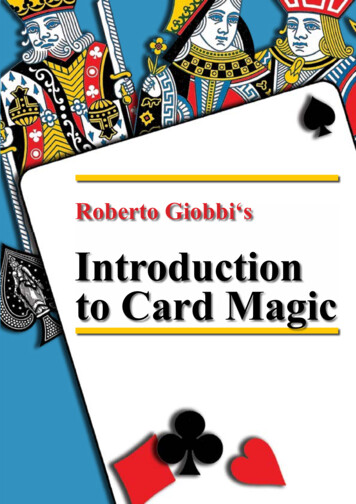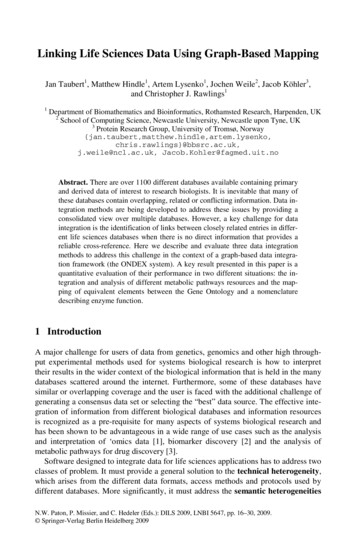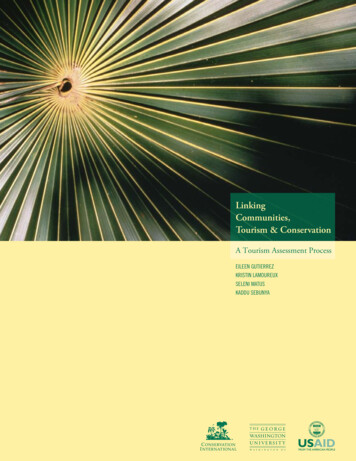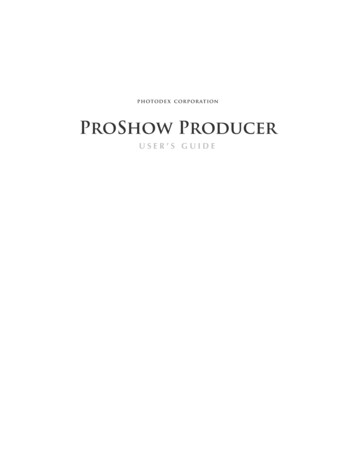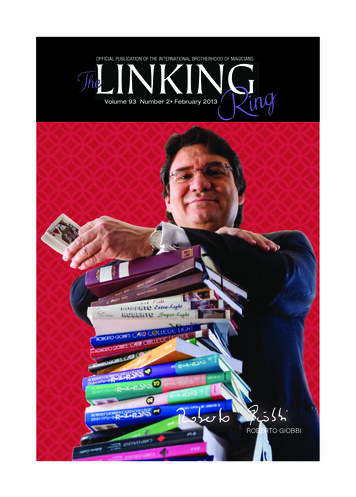
Transcription
LINKINGingROFFICIAL PUBLICATION OF THE INTERNATIONAL BROTHERHOOD OF MAGICIANSTheVolume 93 Number 2 February 2013ROBERTO GIOBBITLRfebCVR.indd 11/22/13 11:41 AM
PP 3-18 AD MASTER PAGES.qxp 1/22/13 2:01 PM Page 5This in-depth and engaging interview with one of magic’s leadingteachers of card magic introduces an exciting member benefitfor 2013 – Roberto Giobbi’s Introduction to Card Magic, a textand video book available for free download.28 I.B.M. LANCE BURTON TEEN SEMINARif you are between the ages of 13 and 19, join Jeff McBride,Eugene Burger, and Lance Burton for this exciting event July 15-17,immediately preceding the i.B.M. Convention in Phoenix, arizona.32 CHINA’S GRAND PLANSwith a potential audience of 1.3 billion, government officials in Chinahave mapped out an ambitious plan for the development of a magicindustry, discussed at The First Beijing international Magic Carnival.39 THE STORY OF THE LINKING RING, PART SIXwhen twenty-year-old Hazel Miller applied for a job with a localsign company, little did she – or her boss – realize the pivotal roleshe would play in the i.B.M. for the next quarter-century.74 SHOULD YOU BE A MENTORCliff Harden tells of unexpectedly becoming a magic mentor and thepositive results both he and his student experienced.203239COLUMNSVOLUME 93 NUMBER 2 FEBRUARY 201320 OUR COVER: ROBERTO GIOBBITHE LINKING RINGFEATURESDEPARTMENTS16 FROM THE EDITOR17 THE PRESIDENT’S PAGE60 POLISHING THE RINGS62 THE KID-SHOW CIRCUIT64 BUSINESS OF THE SHOW66 CUTTING UP JACKPOTS69 THE LONDON EYES30 YOUTH TRIVIA CONTEST108 HOCUS IN FOCUS114 BROKEN WAND119 RING REPORTS157 APPLICATIONS/REINSTATEMENTSMISCELLANEOUSTRICK SECTION81 ROBERTO GIOBBI ONE-MAN PARADE96 THE CARD CORNER100 WAYS AND MEANS102 SHOWTIME104 STORYTELLING MAGIC18 PICTURES FROM THE PAST19 MEMBERSHIP CONTEST36 FLORIDA STATE CONVENTION44 THE MAGIC HOUSE, PART THREE50 RING EVENTS78 RING LOCATIONS80 SICK & CONVALESCENT159 INDEX OF ADVERTISERSCOVER PHOTO: CHRisTOPH LäsER, swiTzERLandFebruary 2013www.magician.org5
our coverRoberto Giobbit h e g i f t o f t h e mag iBy William E. (“Bill”) EvansInternational President-ElectIt’s March, 2004, and the scene is theCrowne Plaza Hotel in Cincinnati, Ohio,where I am about to be fooled really badby the card magic of someone I have nevermet, but whose reputation has precededhim. The event is Card Clinic hosted byJamy Ian Swiss and Roberto Giobbi. I amholding a deck of cards given to me as asouvenir by Roberto after his last effectwhere I did the shuffling and cutting, andI am excited to have these unusual backdesigns for my collection. After his lecture, Roberto decides he has one last effectto show us. He’s looking for his cards andseems to have forgotten that he gave themto me. I, of course, offer them back and heproceeds with the effect leaving all of usin the room shaking our heads in disbelief over the impossibility of the moment.It was later that we learned he had fooledus all with a deck switch, and I had beenholding the cooler for him the entire time.Such is the genius of Roberto Giobbi.His accolades and accomplishmentsinclude the many books and articles hehas written, including the legendaryCard College books, magazines that20cover story feb2.indd 20have featured his work, and awards hehas received, including the Grand Prix atthe Swiss Championship of Magic andtwo FISM Vice World Championshipsin Card Magic. He is regarded not onlyas one of the top card men in magic butalso as one of the very best teachers.A fantastic I.B.M. Special Edition ofRoberto Giobbi’s Introduction to CardMagic, is now available on the I.B.M.Web Portal for you to download andenjoy. (Login at www.magician.org andclick on Member Benefits.) Sponsored bythe I.B.M. Endowment and DevelopmentFund, this great resource includes over 150pages of text, photographs, and imbeddedvideo. It is the best beginning instructionalcourse in card magic that I have ever seen.Allowing I.B.M. members to access thismaterial as a free member benefit is anexample of his generosity and enthusiasmfor teaching magic. His guidance will takeeven a beginning hobbyist on an enjoyableand satisfying journey. If you are patientand diligent in studying the course, itwill enable you to put on an amazingcard magic program. With this soundwww.magician.orgThe Linking Ring1/22/13 4:21 PM
At home with his books. PHOTO BY Christoph Läserfoundation, you will be able to continueyour studies on an even more advancedlevel in what has been called the “poetryof magic.” There is much to learn aboutthe performance of magic in this projectthat even seasoned performers will findrewarding.Recently I interviewed Roberto – inperson, by telephone, and via email – andproffered the following questions. I thinkyou will find his answers both fascinatingand enlightening.LR: Before you begin to teach actualcard magic, the opening Lessons 1 and 2provide a wonderful history of playingcards and practical tips on card magic performance, including, for example, tips onhow to remove a deck of cards from itscase. Although that premise might seemabsurd to some, Michael Skinner did alot of thinking along these lines as well.February 2013cover story feb2.indd 21Even in Lesson 3, you spend a lot of timeon how to do simple actions in an elegantand precise manner. Many will fail to seethe importance of what you have put forthhere for the beginner. You touch on thisin the Foreword and in the text of theseLessons, but can you expand on the importance of these natural and elegant actionsand learning to do them correctly from thebeginning?RG: When asked for a definition ofvirtuosity, the violinist Yehudi Menuhinanswered, “Virtuosity is when the artistcontrols the instrument, and not viceversa.” In order to do this, it is vital tounderstand the instrument on one side, andwhat to do with it on the other side – thento do it in a personal way; that’s the style,the means of expression. Obviously youneed something to express, which in magicis afforded by the essence of the trick youwww.magician.org211/22/13 4:20 PM
Left: Publicityphoto, 1982.Right: Acceptinga LiteraryFellowship fromthe Academy ofMagical Arts,2012.want to perform and who you are (the eternal question!). All of this is complex andprofound, and for a beginner who is starting his or her journey it is difficult, evenimpossible, to understand all of this. Ittakes years of thoughtful practice to climbthe mountain of knowledge and skill,in order to at some point be able to lookdown and oversee what it is all about.So, how do you master this dilemma?Like in a vicious circle, you’ve got tobreak into it at some point, and a goodidea is to follow the advice of a teacherin your chosen discipline. In Eastern cultures, to follow the way of the teacher isthe acknowledged manner of getting to adegree of competence and later to mastery,whereas in our Western culture, dominatedby the visual rather than the conceptual,especially today, many start by buying afew tricks, DVDs, and maybe books hereand there without particular knowledge orguidance. The culmination of “the blindleading the blind” has been reached byknow-how transfer through the Internet,particularly YouTube and so-called “tuto22cover story feb2.indd 22rials” (a heavy misuse of the term).Therefore, to follow detailed instructionsof even the most simple operations, suchas holding a deck, dealing cards, cutting,and shuffling, is an excellent way to beginone’s journey, to build the foundation onwhich one’s Magic Castle can then beerected room by room, floor by floor, wingby wing, until your very own palace shinesabove Wonderland.LR: The embedded videos are awonderful complement to the text andphotographs to show how the actionshould look. Although they are no substitute for the text when it comes down tolearning details you would miss if you justviewed the video alone, it really helps tosee the action after you have learned thedetails. It’s a beautiful compromise youhave developed.RG: Although I’m essentially a bookperson and have grown up on books likemost of my generation, and in spite ofhaving been very skeptical about thewww.magician.orgThe Linking Ring1/22/13 4:20 PM
place. When reading, all of this can bedone at one’s own leisure and rhythm –and that’s important. Otherwise, thereis no pleasure and no transformation ofinformation into skill, the implementationof the latter along with its understandingof how to use it in the context of a trickbeing the ultimate goal.LR: The overhand shuffle is one of themost important practical techniques forthe performing magician, and you coverit in great detail. In fact, you were verygenerous to include the complete CardCollege description, which leaves nothingout. How did you develop your handlingof the overhand shuffle?Above: The Teacher. PHOTO BY JULIANEZITZELSPERGER Below right: InternationalPresident-Elect Bill Evans and Roberto Giobbi.medium of video for years, the shooting ofCard College 1 & 2: Personal Instructionhas convinced me that videos do havesome advantages with which no writteninstruction can compete. They show youthat a sleight is feasible, how it “looks” (ofcourse it doesn’t “look,” if well done), andin which way it is managed (i.e., elegantlyintegrated within a larger set of actions).The weakness of videos is that theexplanation cannot be as detailed – itwould simply be too long. This is preciselythe strength of a multi-media product suchas my Introduction to Card Magic, wherethe Gestalt of a move can be seen in a shortclip, and then its elements and sub-structures are broken down through photos andtext in their smallest units. These buildingstones can then be studied individuallyand reassembled to form the whole, theGestalt, from which one started in the firstFebruary 2013cover story feb2.indd 23RG: I learned the basic handling fromHugard and Braue’s landmark book, TheRoyal Road to Card Magic, when I was aboy, and only later found out that it camefrom Erdnase’s The Expert at the CardTable, who had already described the useof the left little finger protruding fromthe deck’s inner end. This really is thewww.magician.org231/22/13 4:20 PM
principal difference that makes all injogtechniques safe and natural looking.In Card College, however, I didn’tsimply do a rewrite, a procedure whichin the magic literature was typical forcenturies, but I analyzed the sleight fromscratch, identifying its features and majordifficulties, added accurate illustrations,gave several hitherto unpublished suggestions of handling, and then, in the tricksection following the explanation of thesleight, I eventually showed how to use itwithin a very good trick.A critic once wrote in his blog thatCard College was derivative. He failedto recognize that there is also a conceptual, pedagogical, and didactic originalitywhich can make a publication innovative.I’m very grateful to my friend, Jamy IanSwiss, who pointed out this aspect to me inone of our many conversations.LR: On page fifty-eight, you first talkabout audience management, and thenyou go into it in detail in Lesson 10. Thisis wonderful advice that I hope everyonewill read over and over. When combinedwith visualization of the effect as the audience sees it, it seems to me you have agood basis for developing presentations24cover story feb2.indd 24Left to right: A 2001 performance inBürgenstock, Switzerland, for executives of alarge pharmaceutical company. 2011 MagicSymposium lecture. Roberto visits Steve Fortein his private gambling museum in Las Vegas.and writing scripts. How do you go aboutdeveloping presentations for effects?RG: That’s one of the questions I’dhave to write a book about. But since thiswould go beyond the scope of this interview, let me say something that is maybeatypical. I agree with my friend andmentor Juan Tamariz, who in his lecturesprovocatively says, “Presentation is notimportant.” What he means, of course,is that presentation does have its importance, without doubt, but there are twoother things which are more important andcome first, namely the performer’s personand the essence of the effect.What does this mean in respect to yourquestion?One, that when looking for a presentation it should be one that comes out ofwho you are and what you believe in thisworld. As the classic Greek philosopherstaught, we are what we do, but if we dowhat others do, we are not being our-www.magician.orgThe Linking Ring1/22/13 4:20 PM
selves. I remember T. A. Waters telling methis when we first met at the Magic Castle,and I never forgot that. This is not easy tounderstand, especially for beginners, wholearn from imitation, an established path.At some point in one’s evolution, this pathshould be abandoned. You can still look atthis path, but for inspiration, not for lifting.Two, the basic effect within the trick inquestion, as well as the structure of thetrick itself, offer clues to the presentation. Thomas Keller, one of the world’stop chefs, explains in his book Ad Hocat Home, that salt in cooking is used toenhance the product’s inherent flavors,while pepper is a spice and is added ontop. This is an excellent analogy for magic.I believe it is first necessary to fully understand what the essence of the trick is andhow it can be expressed, without toppingit with unnecessary spices, which wouldruin the product and eventually the dish.Typical presentational ploys that can ruina trick, if not carefully dosed, are lengthytexts, stories, and comedy. However, ifapplied by an inspired artist, they willenhance even the simplest trick.LR: The first effect you teach is “TheMystery of the Triangle.” There is a lot ofFebruary 2013cover story feb2.indd 25good advice onperforming cardmagic just in thedescription of thisone effect. In fact,there is a wealthof information onthe performanceof close-up magicscattered throughout this project.To me, that’s thereal value of thismaterial,andthat’s why it’s notjust for beginners.You really have taken the time to makethis project the best that it can be. Can youtalk a little about who has influenced yourapproach to card magic the most?RG: I’ve always believed that a goodteacher should not only give fish, but alsoand above all teach fishing. This is whyI take great care in not only choosing agood technique, trick, or presentation, butI also make a point of naming and explaining the inherent principles that make allof this work. These are polyvalent concepts that, once understood and practiced,will be installed as skills and can then beapplied to every trick one studies and performs from then on. This, in my opinion, istrue progression and leads to personal andartistic maturity.I learned this way of holistic and humanistic thinking from my major teachers,Juan Tamariz and Arturo de Ascanio, andit is the way of thinking and the approachof the Escuela Magica de Madrid, not aphysical school, but a school of thoughtprecisely founded by the aforementionedMasters of Magic.LR: How do you practice card magic,and what advice do you have to the begin-www.magician.org251/22/13 4:20 PM
ner embarking on this Introduction to CardMagic?ing more can be added, but when nothingmore can be taken away.RG: I conceived the course to be studied chronologically, and that’s the way Iadvise it should be used. Maybe you canskip the first two chapters and immediately do a hands-on full immersion, butwhen repeating the course, read the chapter on the history of playing cards as wellas the other basic information, as I think abetter understanding of the larger contextof magic – not only card magic! – can begained from it.As for how to practice, well, I wrote acomplete essay on the subject in CardCollege: Volume 2, and I can’t repeat allof it here. But remember two things: First,make sure you enjoy practicing and makeevery moment of it a moment of joy inyour life. Especially when you have atough job during the day (or night), thinking about magic, reading a good magicbook or magazine, and practicing can beincredibly relaxing and inspiring. Second,whenever you practice try to do one littlething better than last time – and rememberthat perfection isn’t attained when noth-LR: I really liked the “Golden Rules.”There is so much good advice containedin these jewels of wisdom. How did youdecide which principles deserve “GoldenRule” status?RG: I have now been into magic since1973. As of today, that is exactly fortyyears, and since 1988 I have been a fulltime professional performer, author, andteacher. If in this time I hadn’t understoodwhat magic is or should be about, it wouldmean that I had wasted all these years. Soit is by looking at the whole of magic andwhat makes it work – my lifetime experience as well as Decremps’s pre-establishedrules – that I formulated what I called the“13 Golden Rules of Magic.”LR: In Lesson 11, you bring all that youhave taught in the earlier lessons togetherto allow the student to create a card magicprogram that’s quite good. And this resultis achievable by the student who maynever have performed card magic in his orher life. That’s simply amazing. You havereally done a service for ourmembers who might wantto do card magic but had noidea of where to start. Thankyou for this. Those of us thathave been doing this for awhile could have used thisway of teaching when firststarting out. It would havesaved so much time in accumulating knowledge.Roberto with Juan Tamariz (left) and John Carney.26cover story feb2.indd 26www.magician.orgRG: Einstein once saidthat if you can’t explain something complex in simple wordsor to a child, you haven’t reallyThe Linking Ring1/22/13 4:20 PM
RG: As you say, this courseis just the first step into the fascinating and complex world ofcard magic. Those who wereonly looking to learn a few effective tricks and how to properlyhandle a deck of cards will haveall they need. Those, however,who through this course havecome to realize that there is awhole universe to be discoveredbeyond it will be well advised tocarefully consider the next steps.Although I never planned this toBarbara and Roberto, 2012, in one of Giobbi’s twobe so in 1992, when I first pubhome libraries.lished Volumes 1 & 2 of CardCollegeinthe German original, it seemsunderstood it. This course was a challengefor me to take an immensely complex and it has become a standard, a fact which stillprofound subject, which is magic with amazes me.If one likes books, I recommend gettingplaying cards, and break it down into itsmost basic components, explain and teach the first two volumes, as they are reallythem based on three didactical pillars – one book split in two for ease of reading.text, photography, and video – and at the They contain what I think to be the basissame time merge technique, presentation, in technique, effects, and an overview ofand theory in such a way that it doesn’tthe theoretical foundation that make notfeel like work, but appeals to the playfulonly card magic but the whole of magicadult. I hope I have succeeded. Our colleague I.B.M. members will tell us at some work. For those who prefer a quick accesspoint – maybe by hitting the “donate” to the subject and video instruction, I recommend my DVD set, Card College 1 &button!2 – Personal Instruction. Initially I wasLR: In the early lessons, you spend time skeptical about translating the books toteaching how to hold the cards, shuffle video, but I must say that they turned outthe cards, and cut the cards. These pro- much, much better than I thought, andcedures may seem obvious and simple many say it is like taking private lessons.to the uninitiated, but in Lesson 12, you I won’t argue.teach techniques that require some of thoseHGbasic procedures. This is the foundationfor advanced sleight of hand, and Card(Editor’s Note: You can order a signedCollege would be the obvious place for thesetof the DVDs directly from the author bystudent to continue his work after masteremailinghim at the address contained ining the lessons of this project, would itthe PDF.)not?February 2013cover story feb2.indd 27www.magician.org271/22/13 4:20 PM
PP 81-95 Layout 1 1/21/13 11:43 PM Page 1RobertoGiobbiOne-Man ParadeBy Roberto GiobbiIllustrated by Tony DunnPHOTO BY ZAKARY BELAMYoberto Giobbi was born inBasle, Switzerland, on May1, 1959. He has a mathematical and scientific background, hasstudied literature and linguistics,and is fluent in six languages.Since 1988 he has been working asa professional magician, author,and lecturer. At the WorldChampionship of Magic he wonthe title of Vice World Championin Card Magic twice, and as thewinner of all categories receivedthe Grand Prix in Switzerland.Roberto is a leading thinker andauthor of magic. He is a member ofthe Escuela Magica de Madrid, magic’s only Think Tank, with forty membersworldwide. He has written essays and columns for over fifty magic magazinesworldwide and is the author of the five bestselling volumes of Card College,which are the most widely translated magic books in history and are consideredglobally as the ultimate reference work for card magic.Roberto also has an international reputation as a teacher. He is a sought-afterlecturer and coach for professional magicians and also gives interdisciplinarytalks and workshops for industry managers on creativity, communication, andpresentation.Roberto Giobbi is married to Barbara, who also illustrates his books. Theyhave two sons, Rafael (21) and Miro Alessandro (19). Robert lives and works inSwitzerland, near Basel.To read his new interactive book, Roberto Giobbi’s Introduction to CardMagic, which combines solid written explanations with video instruction, visitthe I.B.M. Web Portal at www.magician.org and click on Member Benefits.RFebruary 2013www.magician.org81
PP 81-95 Layout 1 1/21/13 11:43 PM Page 2Deck Switches forMagiciansThe deck switch is one of the most powerful principles in the whole realm of cardconjuring. A good deck switch allows youto introduce decks with the most sophisticated set-ups and all those fantastic specialdecks with which you can produce effectsin the miracle category. You can start andend clean, which is as close as you cancome to creating the impossible.The topic is fascinating but also highlycomplex, and one that justifies a book. Bythe time you are reading this Parade, mybook on the subject, The Deck Switch Book,will have been published by HermeticPress. Here is a synopsis of some of thetechniques and tricks described plus someadditional comments.Categories of Deck Switches: I have acollection of more than one hundred sixtydeck switches, but they can all be placedinto one of the following four categories:Mechanical Deck Switches, whichrequire some kind of apparatus to affect theswitch, such as a special box (e.g.,Fantasios’s commercially available “DeckSwitcher”), a table, chair, etc.Technical Deck Switches, whichrequire pure sleight-of-hand to switch thedecks. Cheats at the card table typicallyemploy these, and you can see some prodigious examples by entering “deck switch”into YouTube.Deck Switches Depending on a Trick.In my opinion, this is the most interestingand useful category for the working magician. It allows the deck in use to beswitched for the cold deck either in thecourse of a specific trick or in the offbeatbetween two tricks.Substitute Deck Switches. This is acategory I discovered only recently whichallows you to “openly” switch decks without the audience realizing that a switch hasoccurred.Let’s now look at a few very practicalexamples that won’t require any specialequipment and that can be used almost82anytime and under virtually all circumstances.The Finger-tongs SwitchThis is a basic handling that is used inmany deck switches where the hand withthe deck in use is inserted in a pocket andcomes out with the cold deck. “The PocketSearch Deck Switch” and “The NinjaDeck Switch,” described next, are twoexamples. The context and managementcan be very different, but the fingeringdescribed here will always be the same.HANDLING: Hold the deck in lefthand dealing position – normally this willbe face down but could be face up in somecontexts. The cold deck is in the left outerpocket of your coat, back towards yourbody.Under some pretext provided by theindividual trick, slide your left hand intothe coat’s pocket, sliding along the fabricthe heel of the thumb pressing lightlyagainst your body (Fig. 1). This ensuresthat the deck held will be positioned to theright of the cold deck, closer to your body.As soon as the hand and its deck enter thepocket, the left forefinger moves from theouter end to the right side of the deck andtakes over control with the thumb, whilethe middle, ring and little fingers aresplayed out as a unit (Fig. 2).These three fingers, acting as a unit onone side, form a sort of “finger tongs” withthe forefinger on the other side. Slide the“finger tongs” over the cold deck’s upperlong side (Fig. 3). The finger tongs grip thecold deck firmly, while the deck in use isreleased by the thumb and forefinger andfalls into the pocket (Fig. 4).www.magician.orgThe Linking Ring
PP 81-95 Layout 1 1/21/13 11:43 PM Page 3The hand comes out of the pocket, but assoon as the thumb has passed the upperlong side of the deck in use, it is placed ontop of the cold deck. Simultaneously, theforefinger shifts its position to the outerend, so by the time the hand and deckreemerge from the pocket, the deck is heldin standard dealing position and theGestalt of hand and deck is the same asbefore (Fig. 5).Details of Handling. In most cases –and we will discuss two examples later –this handling will be used in a situationwhere both hands go to the pockets, usually putting something away or looking foran object. In such instances the right handacts as an additional blocker.The usual rhythm will be as follows:Both hands go to the pockets, but the righthand precedes the left hand by about onesecond. Then the right hand comes out ofits pocket about a second before the lefthand, thus attracting the audience’s attention and affording additional shade for theleft hand.Besides precise fingering, the mostimportant things are attitude, timing, andmisdirection. The attitude is responsiblefor expressing unconcerned nonchalance.The timing makes the action last barelytwo seconds – between the beginning ofthe dipping action and the end of it, whenhand and deck are again in starting position, you can count two Mississippis andyou’re done. The misdirection is activatedby looking into the audience and sayingsomething amusing, for a laugh alwayscauses the audience to relax. You can alsoFebruary 2013ask a question, for a question such as, “Hasanybody got a clean handkerchief?” or“Has anybody got a pen?” has great misdirective power.Capably coordinated attitude, timing,and misdirection, as well as impeccabletechnique, will result in the impression thatthe hand casually dips in and out of thepocket. It will appear to never have happened, like a ninja’s movement.This grip also works with a partial deckor a small packet, of course – a fact not tobe neglected.The Pocket-Search Deck SwitchThis is what I would call the template forthis type of switch as it contains the essential elements of technique, handling, management, timing, and misdirection. Oncethese concepts are understood, almost anymodule can be varied, including but notlimiting to specially made gimmicks todrop the deck in use and to hold the colddeck.EFFECT: The performer looks for hispen, briefly patting his coat from the outside and eventually finds it in his left innerpocket. In this brief “searching action” thedeck is imperceptibly switched.SET-UP: The loose cold deck rests onits side in the left outer coat pocket, backtowards your body.PERFORMANCE: The deck is heldface down in left-hand dealing position. Togive this deck switch a minimal context,let’s assume a spectator has just taken acard, which she is showing around to theothers. Say, “Please look at the card andwww.magician.org83
PP 81-95 Layout 1 1/21/13 11:43 PM Page 4remember it. I would also kindly ask you tosign it on its face. Have you got a pen thatcan write on playing cards?” Pause for justa beat, and then continue, “Wait a minute –I have one here!” The time it takes to pronounce these or similar words, dictated bythe context of your application, is the timespan in which the deck switch occurs.Here are the mechanics: The right handstarts the movement by going into the rightouter coat pocket, feeling for the pen(Fig. 6). By moving first it will attract theaudience’s attention.One second later the left hand with thedeck in use goes to the left coat pocket withthe same intention of looking for a pen, butimmediately does the finger-tongs switchdescribed above, seizing the cold deck. Fora fraction of a second both hands are intheir respective pockets (Fig. 7), for assoon as the left hand enters its pocket, theright hand already starts to come out of itspocket and goes straight up to breastheight, feeling the inside coat pocket fromthe outside (Fig. 8).Again, one second after the right handcomes out, the left hand re-emerges fromits pocket with the cold deck held face84down in dealing position. The left handalso goes straight up, touching the coatfrom the outside and feels that there is apen inside (Fig. 9). Now you rememberthat you always have your pen there,maybe with this silent script: “Of course,here it is!” The position depicted in the figure is held less than a second.Immediately the left hand opens the leftside of the coat, allowing the right hand toenter it and seize the pen (Fig. 10).www.magician.orgThe Linking Ring
PP 81-95 Layout 1 1/21/13 11:43 PM Page 5the whole as a sentence. Now simply makea grammatically correct, clearly understandable sentence, and you’ve got it!Like any other good strategy andsleight, you don’t want to use this morethan once in the same performance andbefore the same audience.Instead of a pen you could be looking fora letter opener to open a prediction envelope. Or maybe you take out a magnifyingglass, which will allow a spectator to seewhat you are about to demons
20 OUR COVER: ROBERTO GIOBBI This in-depth and engaging interview with one of magic’s leading teachers of card magic introduces an exciting member benefit for 2013 –Roberto Giobbi’s Introduction to Card Magic, a text and video book availab
